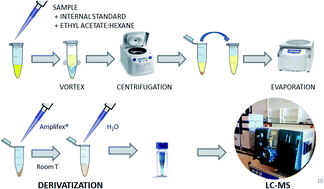Liquid chromatography-tandem mass spectrometry for monitoring vitamin D hydroxymetabolites in human aqueous humor†
Abstract
A stable isotope dilution liquid chromatography tandem mass spectrometry (LC-MS/MS) method was developed and validated for the determination of 24,25-dihydroxyvitamin D3 (24,25(OH)2D3) and 25-hydroxyvitamin D3/D2 (25(OH)D3/D2) in human aqueous humor samples from the Eye-D study. Optimum sample preparation is based on simple liquid–liquid extraction (LLE) followed by derivatization with an Amplifex reagent prior to LC-MS/MS in order to enhance analyte sensitivity. The average recoveries for 24,25(OH)2D3 (0.02, 0.05, 0.4 μg L−1), 25(OH)D3 (0.2, 0.5,3.75 μg L−1) and 25(OH)D2 (0.15, 0.4, 3 μg L−1) ranged from 92 to 112 with a coefficient of variance (CV) lower than 15%. The limits of quantitation (LOQs) were from 0.02 μg L−1 (24,25(OH)2D3) to 0.2 μg L−1 (25(OH)D3) using a sample volume of 50 μL. We demonstrated that the present method provides adequate sensitivity, selectivity, accuracy, and robustness to screen for vitamin D metabolites in aqueous humor samples by analyzing five samples which were withdrawn during cataract operation.



 Please wait while we load your content...
Please wait while we load your content...